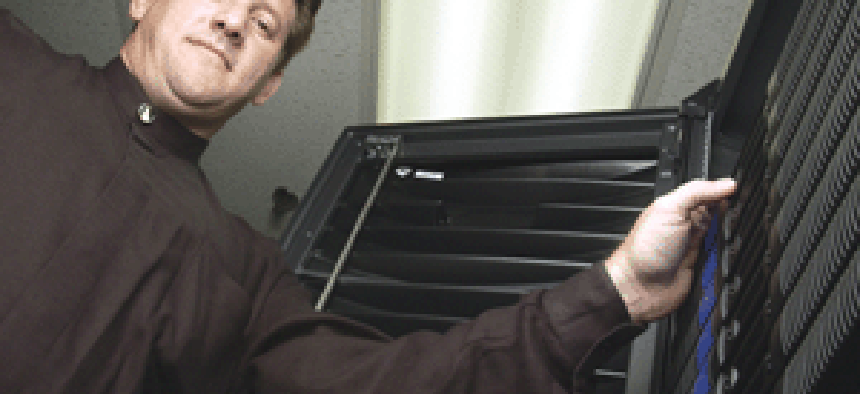Anatomy of a multimedia system

In June, the Defense Department awarded TranTech Inc., Alexandra, Va., a $9 million contract to build an asset management system to hold digital images, audio, video and other documents.
In June, the Defense Department awarded TranTech Inc., Alexandra, Va., a $9 million contract to build an asset management system to hold digital images, audio, video and other documents. In early 2004, TranTech will deliver a solution that will capture, edit, index, store and search digital images, video and audio files. It will aggregate material now held in other repositories run by the Defense Visual Information Center, the Joint Visual Information Services Distribution Activity and others.Eventually this system, called Visual Information Management System, or VIMS, and run by the American Forces Information Service, will be able to hold more than 100 terabytes of content, and will be available for all Defense Department and other federal agencies. The Pentagon never really planned for the huge amount of multimedia files that have been amassed in recent years, said Mark Wells, technical director of TranTech. The American Forces Information Services' Joint Combat Camera Command, for instance, dispatches videographers and photographers around the world to record combat. In Iraq, they captured 2,000 images a day. However, no dedicated system stores, indexes and archives this material. "There is no tracking or the maintaining of [digital] material, so they're waking up to the fact that this is a big problem," Wells said.Archiving multimedia files is a complicated task. While many tools exist to index and search text forms and Web pages, tools for searching digitally based visual material are still emerging. To get help, TranTech turned to a number of solutions providers, including Artesia Technologies Inc., Rockville, Md.; Convera Corp., Vienna, Va.; EMC Corp., Hopkington, Mass.; and Virage Inc., San Mateo, Calif."The contract we had was to take a lot of the products from the commercial world and integrate them together in a customized solution," Wells said. Serving as the hub for VIMS is Artesia's Teams digital asset management software. It will link different components of the system, such as the search engine and the storage arrays. Teams also will define how the system will interface with other defense asset management systems. TranTech can define where files get routed once they enter the system. Digital asset management is an offshoot of the document management market and focuses on digital multimedia content. In this space, Artesia competes with companies such as Canto Software Inc.A privately held company that employs about 80 employees, Artesia generates $10 million to $20 million in revenue annually, said Scott Bowen, president and chief executive officer of the company.Although Artesia bundles a search engine with its solution, TranTech decided to go with one offered by Convera, which employs about 215 people and reported 2003 sales of $23.6 million. Convera's technology was developed in part through funding from the Defense Advanced Research Projects Agency. However, the company rapidly applied its technology to the commercial market.Convera, which competes with the likes of Verity Inc. and Autonomy Corp. plc., has carved out a niche for being able to search multimedia content, said Sean Alger, Convera's vice president and general manager of federal sales and services. "Convera has a very sophisticated search engine," TranTech's Wells said. "I can search for shape, color, transition. I can do a search, for example, on a triangular shape, and it would find videos of the pyramids or images of triangular buildings." Once the user chooses a particular image, the search engine will go back and find other related images or video footage.Convera's RetrievalWare can execute keyword and semantic searches, so TranTech sought a video logger that could provide summary files of materials entering the system. Virage supplied software that could tag incoming footage and images with keywords and descriptions that are used in a searchable index."It is able to bring in all the content you want and catalog it on the fly," Wells said. The video logger watches video, television or satellite streams for notable faces, themes, places and keywords. Anything of interest is tagged with descriptive data and handed off to Teams to send to storage. Virage, which employs 115 people, sold about $13 million worth of solutions for fiscal 2003, said Dave Girouard, senior vice president for marketing and business development. Its technology also has roots in DARPA funding. Now, about 20 percent of the company's business is in the government sector through direct sales or through partners, such as Science Applications International Corp. Virage competes with companies such as Convera and OpenText Corp., Waterloo, Ontario.To store all this data, TranTech chose the Centera storage array from EMC. "The main reason we chose that product over a lot of other storage arrays was that there were particular requirements on this contract that necessitate the Centera array," Wells said. One requirement was for VIMS to check for duplication. The American Forces Information Service, seeing how many asset systems are filled with multiple copies of a single image, required that no image be duplicated on the system. EMC's storage could characterize an image coming into the system and check if it's already entered elsewhere, Wells said. Centera also has a capability to track document changes, fulfilling another requirement. "If someone changes an original asset in some way, it maintains the change that occurred and relates it back to the original asset," Wells said. Doug Cahill, senior manager of compliance technology for EMC, said the government market is one of select verticals that the company focuses on for Centera. For 2002, the company reported $5.4 billion in sales, with a net loss of $119 million. EMC competes in the storage space with companies such as Hewlett-Packard Co. and Hitachi Data Systems Corp. Each participating company hopes VIMS becomes a standard bearer for future systems in what is still a nascent market for digital asset management. TranTech itself is pitching the solution to other agencies, such as the Air Force."There's a huge, pent-up demand for this kind of thing. There's a lot of footage that's still stored on 16-millimeter film," said Alger, who sees an immediate market for systems that will interoperate with VIMS. Beyond that, the civil agencies may use this approach. NASA, for instance, has expressed an interest."The bar gets raised by projects like this," Virage's Girouard said. "Once users get accustomed to searching for information in one format, they start asking why it takes so long to get other kinds of content." Staff Writer Joab Jackson can be reached at jjackson@postnewsweektech.com.
 Cutting-edge technologies power TranTech's new defense digital asset management
Cutting-edge technologies power TranTech's new defense digital asset management

Mark Wells, technical director of TranTech, said the Defense Department never really planned for the huge amount of multimedia files it has amassed in recent years .
Henrik G. de Gyor
NEXT STORY: Optical disc advancement

